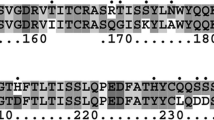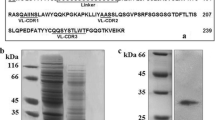Abstract
One of the primary pathological mechanisms underlying Alzheimer’s disease (AD) is the deposition of amyloid β-protein (Aβ42) aggregates in the brain. In this study, a catalytic anti-oligomeric Aβ42 scFv antibody, HS72, was identified by screening a human antibody library, its ability to degrade Aβ42 aggregates was defined, and its role in the reduction of Aβ burden in the AD mouse brain was evaluated. HS72 specifically targeted Aβ42 aggregates with an approximately 14–68 kDa range. Based on molecular docking simulations, HS72 likely catalyzed the hydrolytic cleavage of the His13-His14 bond of Aβ42 chains in an Aβ42 aggregate unit, releasing N/C-terminal fragments and Aβ42 monomers. Degradation of Aβ42 aggregates by HS72 triggered a considerable disassembly or breakdown of the Aβ42 aggregates and greatly reduced their neurotoxicity. Aβ deposit/plaque load in the hippocampus of AD mice was reduced by approximately 27% after 7 days (once daily) of intravenous HS72 administration, while brain neural cells were greatly restored and their morphology was drastically improved. The above efficacies of HS72 were all greater than those of HT7, a simple anti-oligomeric Aβ42 scFv antibody. Although a catalytic anti-oligomeric Aβ42 antibody may have a slightly lower affinity for Aβ42 aggregates than a simple anti-oligomeric Aβ42 antibody, the former may display a stronger overall efficacy (dual efficacy of induction and catalysis) than the latter (induction alone) in clearing Aβ42 aggregates and improving histopathological changes in AD brain. Our findings on the catalytic antibody HS72 indicate the possibility of functional evolution of anti-oligomeric Aβ42 antibodies and provide novel insights into the immunotherapy of AD.







Similar content being viewed by others
Abbreviations
- AD:
-
Alzheimer’s disease
- Aβ42:
-
Amyloid β-protein 1–42
- scFv:
-
Single-chain variable fragment
- HSA:
-
Human Serum Albumin
- DMEM:
-
Dulbecco’s modified eagle’s medium
- HPLC:
-
High-performance liquid chromatography
- ELISA:
-
Enzyme-linked immunosorbent assay
- SD:
-
Standard deviation
- HE:
-
Hematoxylin-eosin
- IHC:
-
Immunohistochemistry
References
Thoe ES, Fauzi A, Tang YQ, Chamyuang S, Chia AYY (2021) A review on advances of treatment modalities for Alzheimer’s disease. Life Sci 276:119129. https://doi.org/10.1016/j.lfs.2021.119129
Vaz M, Silvestre S (2020) Alzheimer’s disease: recent treatment strategies. Eur J Pharmacol 887:173554. https://doi.org/10.1016/j.ejphar.2020.173554
Cline EN, Bicca MA, Viola KL, Klein WL (2018) The Amyloid-β Oligomer Hypothesis: beginning of the third decade. J Alzheimers Dis 64(s1):S567-s610. https://doi.org/10.3233/jad-179941
Fontana IC, Zimmer AR, Rocha AS, Gosmann G, Souza DO, Lourenco MV, Ferreira ST, Zimmer ER (2020) Amyloid-β oligomers in cellular models of Alzheimer’s disease. J Neurochem 155(4):348–369. https://doi.org/10.1111/jnc.15030
Saito Y, Sakata M, Kobayakawa M, Kawachi H, Kawaguchi K, Hiki Y, Kato M, Mori M et al (2020) Removal of Aβ oligomers from the blood: a potential therapeutic system for Alzheimer’s Disease. Neuropsychiatr Dis Treat 16:607–627. https://doi.org/10.2147/ndt.S241074
Kitaguchi N, Kawaguchi K, Sakata M, Aoki H, Yamazaki K, Kaneko M, Kinomura J, Kato M et al (2021) Aβ influx into the blood evoked by different blood Aβ removal systems: a potential therapy for Alzheimer’s Disease. Neuropsychiatr Dis Treat 17:2291–2308. https://doi.org/10.2147/ndt.S317104
Maarouf CL, Walker JE, Sue LI, Dugger BN, Beach TG, Serrano GE (2018) Impaired hepatic amyloid-beta degradation in Alzheimer’s disease. PLoS One 13(9):e0203659. https://doi.org/10.1371/journal.pone.0203659
Ni A, Li H, Wang R, Sun R, Zhang Y (2023) Degradation of amyloid β-peptides catalyzed by nattokinase in vivo and in vitro Food Sci Hum Wellness 12(5):1905–1916. https://doi.org/10.1016/j.fshw.2023.02.042
Pollack SJ, Jacobs JW, Schultz PG (1986) Selective chemical catalysis by an antibody. Science 234(4783):1570–1573. https://doi.org/10.1126/science.3787262
Tramontano A, Janda K, Napper AD, Benkovic SJ, Lerner RA (1987) Catalytic antibodies. Cold Spring Harb Symp Quant Biol 52:91–96. https://doi.org/10.1101/sqb.1987.052.01.013
Paul S, Volle DJ, Beach CM, Johnson DR, Powell MJ, Massey RJ (1989) Catalytic hydrolysis of vasoactive intestinal peptide by human autoantibody. Science 244(4909):1158–1162. https://doi.org/10.1126/science.2727702
Hifumi E, Taguchi H, Toorisaka E, Uda T (2019) New technologies to introduce a catalytic function into antibodies: a unique human catalytic antibody light chain showing degradation of β-amyloid molecule along with the peptidase activity. FASEB Bioadv 1(2):93–104. https://doi.org/10.1096/fba.1025
Taguchi H, Planque S, Nishiyama Y, Symersky J, Boivin S, Szabo P, Friedland RP, Ramsland PA et al (2008) Autoantibody-catalyzed hydrolysis of amyloid beta peptide. J Biol Chem 283(8):4714–4722. https://doi.org/10.1074/jbc.M707983200
Zhang X, Huai Y, Cai J, Song C, Zhang Y (2019) Novel antibody against oligomeric amyloid-β: insight into factors for effectively reducing the aggregation and cytotoxicity of amyloid-β aggregates. Int Immunopharmacol 67:176–185. https://doi.org/10.1016/j.intimp.2018.12.014
Zhang Y, Chen X, Liu J, Zhang Y (2015) The protective effects and underlying mechanism of an anti-oligomeric Aβ42 single-chain variable fragment antibody. Neuropharmacology 99:387–395. https://doi.org/10.1016/j.neuropharm.2015.07.038
Zhang Y, Huai Y, Zhang X, Song C, Cai J, Zhang Y (2019) The Mode of Action of an anti-oligomeric amyloid β-Protein antibody affects its protective efficacy. Neurotox Res 35(2):304–317. https://doi.org/10.1007/s12640-018-9955-6
Yang B, Li H, Zhang T, Wang Z, Li H, Zhang Y (2020) Nonlinear and mixed inhibitory effect of matrine on the cytotoxicity of oligomeric amyloid-β protein. Neurochem Int 137:104746. https://doi.org/10.1016/j.neuint.2020.104746
Huang X, Wang J, Cui L, Zou X, Zhang Y (2010) Recombinant GST-I-A beta 28-induced efficient serum antibody against a beta 42. J Neurosci Methods 186(1):52–59. https://doi.org/10.1016/j.jneumeth.2009.10.026
Zhang Y, Sun Y, Huai Y, Zhang YJ (2015) Functional characteristics and molecular mechanism of a new scFv antibody against Aβ42 oligomers and immature protofibrils. Mol Neurobiol 52(3):1269–1281. https://doi.org/10.1007/s12035-014-8910-7
Jonkman JE, Cathcart JA, Xu F, Bartolini ME, Amon JE, Stevens KM, Colarusso P (2014) An introduction to the wound healing assay using live-cell microscopy. Cell Adh Migr 8(5):440–451. https://doi.org/10.4161/cam.36224
Zhang T, Song C, Zheng C, Chen X, Zhang Y (2023) Extracellular amyloid β-protein (1–42) Oligomers Anchor Brain cells and make them inert as an unconventional integrin-coupled ligand. Cell Mol Neurobiol 43(2):841–858. https://doi.org/10.1007/s10571-022-01219-2
Blow DM, Birktoft JJ, Hartley BS (1969) Role of a buried acid group in the mechanism of action of chymotrypsin. Nature 221(5178):337–340. https://doi.org/10.1038/221337a0
Hedstrom L (2002) Serine protease mechanism and specificity. Chem Rev 102(12):4501–4524. https://doi.org/10.1021/cr000033x
Zhang T, Song C, Li H, Zheng Y, Zhang Y (2022) Different extracellular β-Amyloid (1–42) aggregates differentially impair neural cell adhesion and neurite outgrowth through Differential induction of Scaffold Palladin. Biomolecules 12(12). https://doi.org/10.3390/biom12121808
Moore BD, Martin J, de Mena L, Sanchez J, Cruz PE, Ceballos-Diaz C, Ladd TB, Ran Y et al (2018) Short Aβ peptides attenuate Aβ42 toxicity in vivo J Exp Med 215(1):283–301. https://doi.org/10.1084/jem.20170600
Hernandez-Guillamon M, Mawhirt S, Blais S, Montaner J, Neubert TA, Rostagno A, Ghiso J (2015) Sequential Amyloid-β degradation by the Matrix Metalloproteases MMP-2 and MMP-9. J Biol Chem 290(24):15078–15091. https://doi.org/10.1074/jbc.M114.610931
Song C, Zhang T, Zhang Y (2022) Conformational essentials responsible for neurotoxicity of Aβ42 aggregates revealed by antibodies against oligomeric Aβ42. Molecules 27(19). https://doi.org/10.3390/molecules27196751
Richard JP (2022) Enabling role of ligand-driven conformational changes in enzyme evolution. Biochemistry 61(15):1533–1542. https://doi.org/10.1021/acs.biochem.2c00178
Acknowledgements
Authors thank Yanru Zheng of the School of Life Sciences, Jilin University for her technical assistance with section analysis.
Funding
This work was supported by a grant from the National Natural Science Foundation of China (No. 31970883).
Author information
Authors and Affiliations
Contributions
All authors contributed to the study conception and design. Material preparation, data collection and analysis were performed by Chuli Song, He Li, Tianyu Zhang, Changxin Zheng, Yingjiu Zhang. The first draft of the manuscript was written by Chuli Song and Yingjiu Zhang and all authors commented on previous versions of the manuscript. All authors read and approved the final manuscript.
Corresponding author
Ethics declarations
Ethics Approval
This study was performed in line with the principles of the Declaration of Helsinki. Approval was granted by the Ethics Committee of Servicebio Animal Welfare, Wuhan, China (approval number: 2022113).
Consent to Participate
Not applicable.
Consent for Publication
Not applicable.
Competing Interests
The authors declare no competing or financial interests.
Additional information
Publisher’s Note
Springer Nature remains neutral with regard to jurisdictional claims in published maps and institutional affiliations.
Supplementary Information
Below is the link to the electronic supplementary material.
ESM 1
(PDF 399 KB)
Rights and permissions
Springer Nature or its licensor (e.g. a society or other partner) holds exclusive rights to this article under a publishing agreement with the author(s) or other rightsholder(s); author self-archiving of the accepted manuscript version of this article is solely governed by the terms of such publishing agreement and applicable law.
About this article
Cite this article
Song, C., Li, H., Zheng, C. et al. Dual Efficacy of a Catalytic Anti-Oligomeric Aβ42 scFv Antibody in Clearing Aβ42 Aggregates and Reducing Aβ Burden in the Brains of Alzheimer’s Disease Mice. Mol Neurobiol 60, 5515–5532 (2023). https://doi.org/10.1007/s12035-023-03406-8
Received:
Accepted:
Published:
Issue Date:
DOI: https://doi.org/10.1007/s12035-023-03406-8




